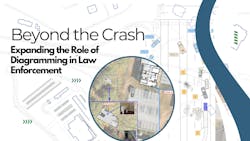Beyond the Crash: Expanding the Role of Diagramming in Police Work
What to Know
- Standardized digital diagrams improve the reliability and clarity of crime scene documentation, aiding investigations and courtroom presentations.
- Integrated diagramming tools streamline data entry, reduce redundancy, and enhance resource sharing across agencies during emergencies.
- Expanding diagramming use to tactical planning and special events enhances coordination, safety, and communication among law enforcement units.
By Aaron Baumert, Global Director of Sales at SmartSafety Software
For decades, the most common use of diagramming in law enforcement has been the reconstruction of motor vehicle crashes. The technique has been vital for understanding traffic patterns, vehicle movements, and the sequence of events that lead to a collision. Yet, focusing on roadway incidents alone has limited the potential of diagramming technology. Advances in both software and practice now allow agencies to employ diagramming as a universal documentation and planning tool. When broadened in scope, diagramming can support investigations, operations, training, and administrative oversight.
This article examines how diagramming extends far beyond crash reconstruction. It explores practical applications for crime scene investigations, tactical planning, emergency response, and community events, while also considering organizational benefits such as standardization, evidentiary reliability, and resource efficiency. The intent is to demonstrate how agencies can expand the value of a familiar tool to address a wide range of operational challenges.
Crime scene investigations
Accurate documentation is fundamental to any criminal investigation. Traditional crime scene sketches, often produced by hand, have long been subject to variation in style and accuracy. Diagramming software reduces those discrepancies by providing standardized templates, symbols, and scaling.
For example, a burglary scene may require depiction of entry points, interior pathways, recovered items, and evidence locations. Using digital diagramming, investigators can produce a clear representation that integrates with photographs, witness statements, and forensic reports. Similarly, violent crime scenes benefit from diagrams that depict the position of victims, weapons, and other physical evidence. These visualizations assist in both investigative analysis and courtroom presentation, where clarity and consistency are critical.
In many jurisdictions, crime scene diagrams are now stored directly within records management systems (RMS). This integration reduces redundant data entry, strengthens evidentiary chains, and ensures that investigators, prosecutors, and administrators are all reviewing the same standardized materials.
Tactical and operational planning
Diagramming is equally valuable as a forward-looking tool. Tactical teams require precise plans for executing warrants, entering buildings, and managing high-risk incidents. A diagram can serve as a shared operational map that illustrates entry routes, interior layouts, officer assignments, and staging areas.
For example, when preparing to execute a narcotics warrant at a multi-unit dwelling, officers can create diagrams that show stairwells, hallways, and points of concern. These diagrams are not limited to static images; they can be updated with annotations, photographs, or geospatial data to provide context. The result is a planning document that enhances both safety and coordination.
Similarly, special event planning (such as parades, festivals, or dignitary visits) requires coordination across multiple agencies. Diagrams of traffic routes, barricade placements, medical aid stations, and command posts provide a visual framework that written orders cannot easily convey. These diagrams facilitate interagency communication and help ensure that every stakeholder is operating from the same reference material.
Emergency and disaster response
Large-scale emergencies, including natural disasters and mass-casualty incidents, require rapid coordination among diverse responders. Diagramming provides a means of capturing both the physical layout of a scene and the deployment of resources in real time.
During flood or hurricane response, for instance, diagrams can mark evacuation routes, shelters, and hazard zones. Wildfire response teams often use diagramming to track containment lines, access roads, and water sources. The ability to produce consistent, to-scale diagrams improves situational awareness for command staff and enhances after-action reviews.
Importantly, digital diagrams can be shared across agencies regardless of jurisdictional boundaries. This interagency applicability strengthens collaboration during crises when resources must be pooled.
Training and administrative oversight
Diagramming also has applications in training environments. Instructors can use diagramming tools to recreate past incidents for scenario-based learning. By depicting the layout of a traffic stop gone wrong, or the structure of a building involved in a hostage incident, trainers provide officers with a more realistic context in which to practice decision-making.
Administrators, meanwhile, benefit from the standardization that digital diagramming enforces. Diagrams created with consistent scale, symbols, and structure support clearer internal reviews, performance evaluations, and compliance audits. For agencies required to demonstrate adherence to reporting standards, diagramming tools provide an auditable, repeatable process.
Lessons learned from expanding use
Agencies that have already expanded diagramming beyond traffic collisions have reported several consistent lessons.
- Standardization Improves Reliability
When officers across different units produce diagrams using the same software, the resulting records share a common format. This reduces confusion, minimizes errors, and improves courtroom presentation. - Integration Saves Time
Agencies that connect diagramming tools to their RMS eliminate the inefficiency of entering the same data multiple times. This integration also ensures that diagrams are securely stored and accessible to all authorized personnel. - Versatility Justifies Investment
While crash documentation may be the entry point, agencies that adopt diagramming for tactical, investigative, and administrative use report greater return on investment. A single tool meeting multiple operational needs reduces training and licensing costs. - Officer Buy-In Requires Ease of Use
Officers are more likely to adopt diagramming software when it is intuitive and requires minimal training. Complex systems discourage use and undermine the benefits of standardization.
Recommendations for agencies
For agencies considering how to expand their use of diagramming, several best practices emerge:
- Conduct a Needs Assessment. Identify the full range of scenarios where diagramming could provide value, including investigations, operations, training, and administration.
- Pilot Across Multiple Units. Rather than limiting a trial to traffic enforcement, involve investigators, tactical teams, and command staff to test broader applications.
- Integrate with Existing Systems. Ensure that diagramming tools connect with your RMS, evidence management, or case management systems to avoid redundant work.
- Develop Standard Operating Procedures. Establish policies that define when diagrams should be created, how they should be formatted, and where they should be stored.
- Provide Training and Support. While modern diagramming tools are designed to be intuitive, agencies should still provide orientation sessions and maintain technical support resources.
Diagramming has long been associated with the reconstruction of traffic collisions. While that function remains important, it should not define the limits of the practice. Law enforcement agencies today face complex challenges that extend far beyond the roadway. Expanding the use of diagramming to include crime scenes, tactical operations, special events, and emergency responses allows agencies to improve accuracy, efficiency, and communication.
By rethinking diagramming as a universal documentation and planning tool, agencies can strengthen investigations, enhance officer safety, and provide courts and communities with clearer, more reliable records. In doing so, they elevate a long-standing practice into a modern standard for law enforcement professionalism.
About the Author
Baumert has over 25 years of experience as a trainer and sales consultant for International, Federal, State and Local agencies with a focus on software and hardware technologies used by law enforcement and military communities. Responsible for deploying technology offerings as well as conducting classes and seminars for all facets of military and law enforcement agencies as well as P.O.S.T certified classes. He is a Charter member of the All-Hazards Incident Management Teams Association (AHIMTA) and an associate member of the International Association of Bomb Technicians & Investigators (IABTI), a member of the NATO Explosive Ordinance Disposal Center of Excellence and a member of the Association of Transportation Information Professionals (ATSIP).

